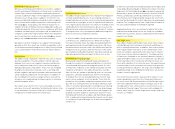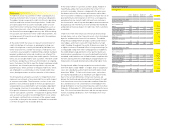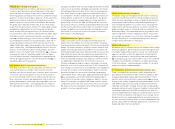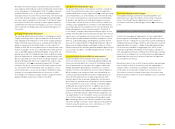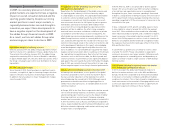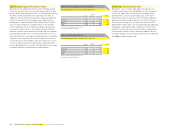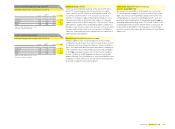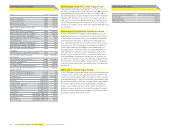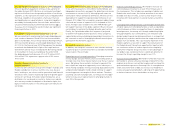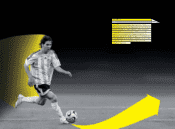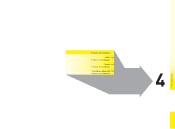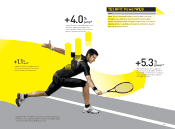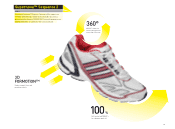Reebok 2008 Annual Report Download - page 125
Download and view the complete annual report
Please find page 125 of the 2008 Reebok annual report below. You can navigate through the pages in the report by either clicking on the pages listed below, or by using the keyword search tool below to find specific information within the annual report.
adidas Group Annual Report 2008 121
European sporting goods industry to decline
compared to prior year
Due to the non-recurrence of positive effects related to the
UEFA EURO 2008™ in the fi rst half of the year, and ongoing
diffi cult market conditions in major Western European markets
such as the UK and Spain, we expect the sporting goods indus-
try to decline in Europe in 2009. While the region’s emerging
markets are likely to be more resilient, we also anticipate a
slowdown in consumer spending to impact sporting goods
industry sales in these markets. In the second half of the year,
the industry is expected to turn its attention to the run-up for
the 2010 FIFA World Cup™, which should provide some positive
impetus to industry sales towards the end of 2009.
North American sporting goods market to
experience consolidation
As a result of the recession in the USA, we expect the North
American sporting goods market to decline in 2009. Accord-
ing to the National Retail Federation, retail industry sales are
expected to fall 0.5% compared to the prior year. Lower overall
consumer spending and potential shifts in consumption pat-
terns away from discretionary products are expected to lead to
shifts in consumer priorities which we expect to also negatively
impact the sporting goods industry. In addition, we anticipate
further consolidation of the retail landscape as several smaller
retailers succumb to fi nancial pressure and many rationalise
existing store bases.
Asian sporting goods industry negatively impacted
by slowing domestic demand
Although we expect Asia to continue to be the fastest-growing
sporting goods market in 2009, we anticipate growth rates to
moderate considerably compared to the prior year. In China,
industry growth is likely to moderate signifi cantly in 2009, due
to the exceptionally high rate of retail expansion in 2008, and
high sell-in rates by sporting goods manufacturers ahead
of the Beijing 2008 Olympics. Nevertheless, we expect the
sporting goods industry in China to show continued growth
in 2009, as underlying consumer trends remain positive and
retail infrastructure continues to develop across the country.
In Japan, however, we expect the sporting goods industry to
decline, in line with private consumption expectations in that
market.
Latin American sporting goods industry affected by
depreciation of currencies against the dollar
With a majority of sporting goods in Latin America being pur-
chased in US dollars, we expect demand for sporting goods to
be negatively affected by the recent depreciation of currencies
in the major countries of the region. In addition, there are
currently concerns related to increasing trade barriers being
potentially implemented in certain markets such as Brazil
see Risk and Opportunity Report, p. 107.
Consolidation of new businesses supports
TaylorMade-adidas Golf and Reebok sales
Sales recorded in the TaylorMade-adidas Golf segment will
be supported by the consolidation of Ashworth, Inc. revenues
for the full twelve-month period. Ashworth, Inc., a US-based
golf lifestyle apparel brand, has been consolidated within the
adidas Group as of November 20, 2008. In addition, sales in the
Reebok segment are expected to be positively infl uenced by the
consolidation of sales from the brand’s new companies in Latin
America for the full twelve-month period.
adidas Group sales and earnings per share
to decrease in 2009
We expect adidas Group sales to decline at a low- to mid-
single-digit rate on a currency-neutral basis in 2009. Sales
development will be negatively impacted by weaker consumer
demand due to low levels of consumer confi dence and rising
unemployment in many major markets. Group currency-
neutral sales in the emerging markets of Europe, Asia and
Latin America are forecasted to develop better relative to
mature markets such as Western Europe and North America.
In 2009, the adidas Group gross margin is forecasted to decline.
A promotional environment in mature markets, as well as
expected higher sourcing costs due to increased raw material
and wage costs, in particular in the fi rst half of the year, will
contribute to this development. Further own-retail expansion
at both adidas and Reebok is expected to partially offset these
developments.
In 2009, the Group’s operating expenses as a percentage
of sales are expected to increase. Higher expenses for con-
trolled space initiatives in the adidas and Reebok segments
will drive increases, partially compensated by positive effects
from effi ciency improvements throughout our organisation.
Marketing working budget expenses as a percentage of sales
are forecasted to be at or below the prior year level. Operating
income is expected to decline. This will mainly be driven by the
non-recurrence of book gains from acquisitions and disposals
in the TaylorMade-adidas Golf segment in the prior year.
We expect the number of employees within the adidas Group to
be around the prior year level. A hiring freeze implemented in
autumn 2008 for all Group and brand functions and initiatives
to streamline our organisation are forecasted to offset new
hirings related to further retail expansion in emerging markets.
The adidas Group will continue to spend around 1% of sales on
research and development in 2009. Areas of particular focus
include training, running, football and basketball at the adidas
and Reebok brands, as well as golf hardware at TaylorMade-
adidas Golf. The number of employees working in research and
development throughout the Group will remain stable in 2009.
In 2009, we expect the operating margin for the adidas Group
to decline. This forecast refl ects our projection of a Group
gross margin decline and an increase in operating expenses
as a percentage of sales.
As a result of lower interest rate expenses in line with the
planned reduction of net borrowings, we forecast lower
fi nancial expenses in 2009. The Group tax rate is expected to
be slightly above the prior year level (2008: 28.8%).
As a result of these developments, net income attributable to
shareholders is projected to decline in 2009. Basic and diluted
earnings per share are expected to decline at a lower rate
than net income attributable to shareholders due to a lower
weighted average number of shares outstanding compared to
the prior year.


